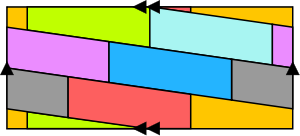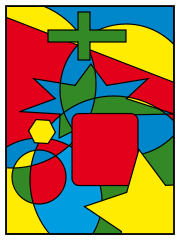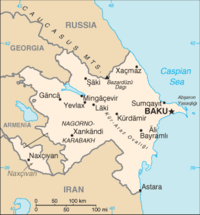Four colour theorem
2008/9 Schools Wikipedia Selection. Related subjects: Mathematics
The four colour theorem (also known as the four colour map theorem) states that given any plane separated into regions, such as a political map of the states of a country, the regions may be colored using no more than four colors in such a way that no two adjacent regions receive the same colour. Two regions are called adjacent only if they share a border segment, not just a point. Each region must be contiguous: that is, it may not have exclaves like some real countries such as Angola, Azerbaijan, the United States, or Russia.
It is often the case that using only three colors is inadequate. This applies already to the map with one region surrounded by three other regions (although with an even number of surrounding countries three colors are enough) and it is not at all difficult to prove that five colors are sufficient to colour a map.
The four colour theorem was the first major theorem to be proven using a computer, and the proof is not accepted by all mathematicians because it would be unfeasible for a human to verify by hand (see computer-assisted proof). Ultimately, in order to believe the proof, one has to have faith in the correctness of the compiler and hardware executing the program used for the proof.
The perceived lack of mathematical elegance by the general mathematical community was another factor, and to paraphrase comments of the time, "a good mathematical proof is like a poem—this is a telephone directory!"
History
The conjecture was first proposed in 1852 when Francis Guthrie, while trying to colour the map of counties of England, noticed that only four different colors were needed. At the time, Guthrie's brother, Fredrick, was a student of Augustus De Morgan at University College. Francis inquired with Fredrick regarding it, who then took it to DeMorgan. (Fredrick Guthrie graduated later in 1852, and later became a professor of mathematics in South Africa). According to De Morgan:
A student of mine [Guthrie] asked me today to give him a reason for a fact which I did not know was a fact - and do not yet. He says that if a figure be anyhow divided and the compartments differently coloured so that figures with any portion of common boundary line are differently colored - four colours may be wanted, but not more—the following is the case in which four colours are wanted. Query cannot a necessity for five or more be invented…
The first published reference is by Arthur Cayley, who in turn credits the conjecture to De Morgan.
There were several early failed attempts at proving the theorem. One proof of the theorem was given by Alfred Kempe in 1879, which was widely acclaimed; another proof was given by Peter Guthrie Tait in 1880. It wasn't until 1890 that Kempe's proof was shown incorrect by Percy Heawood, and 1891 that Tait's proof was shown incorrect by Julius Petersen—each false proof stood unchallenged for 11 years.
In 1890, in addition to exposing the flaw in Kempe's proof, Heawood proved that all planar graphs are five-colorable; see five colour theorem.
Significant results were produced by Croatian mathematician Danilo Blanuša in the 1940s by finding an original snark.
During the 1960s and 1970s German mathematician Heinrich Heesch developed methods of applying the computer in searching for a proof.
It was not until 1976 that the four-colour conjecture was finally proven by Kenneth Appel and Wolfgang Haken at the University of Illinois. They were assisted in some algorithmic work by John Koch.
If the four-colour conjecture were false, there would be at least one map with the smallest possible number of regions that requires five colors. The proof showed that such a minimal counterexample cannot exist through the use of two technical concepts:
- An unavoidable set contains regions such that every map must have at least one region from this collection.
- A reducible configuration is an arrangement of countries that cannot occur in a minimal counterexample. If a map contains a reducible configuration, and the rest of the map can be colored with four colors, then the entire map can be colored with four colors and so this map is not minimal.
Using mathematical rules and procedures based on properties of reducible configurations (e.g. the method of discharging, rings, Kempe chains, etc.), Appel and Haken found an unavoidable set of reducible configurations, thus proving that a minimal counterexample to the four-colour conjecture could not exist. Their proof reduced the infinitude of possible maps to 1,936 reducible configurations (later reduced to 1,476) which had to be checked one by one by computer. This reducibility part of the work was independently double checked with different programs and computers. However, the unavoidability part of the proof was over 500 pages of hand written counter-counter-examples, much of which was Haken's teenage son Lippold verifying graph colorings. The computer program ran for hundreds of hours.
Since the proving of the theorem, efficient algorithms have been found for 4-coloring maps requiring only O(n2) time, where n is the number of vertices. In 1996, Neil Robertson, Daniel P. Sanders, Paul Seymour, and Robin Thomas created a quadratic time algorithm, utilizing Edward Belaga's work to improve a quartic algorithm based on Appel and Haken’s proof. This new proof is similar to Appel and Haken's but more efficient because it reduced the complexity of the problem and required checking only 633 reducible configurations. Both the unavoidability and reducibility parts of this new proof must be executed by computer and are impractical to check by hand.
In 1980, George Spencer-Brown deposited his purported proof of the four colour map theorem at the Royal Society. The validity of this proof, which makes up Appendix 5 of the German translation of his book " Laws of Form" (Lübeck 1997), is generally doubted.
In 2004 Benjamin Werner and Georges Gonthier formalized a proof of the theorem inside the Coq proof assistant (Gonthier, n.d.). This removes the need to trust the various computer programs used to verify particular cases; it is only necessary to trust the Coq kernel.
There are also efficient algorithms to determine whether 1 or 2 colors suffice to colour a map. Determining whether 3 colors suffice is, however, NP-complete, and so a fast algorithm is unlikely. Determining whether a general (possibly non-planar) graph can be 4-colored is likewise NP-complete.
Not for mapmakers
Although the four colour theorem was discovered in the process of coloring a real map, it is rarely used in practical cartography. According to Kenneth May, a mathematical historian who studied a sample of atlases in the Library of Congress, there is no tendency to minimize the number of colors used. Many maps use colour for things other than political regions. Most maps use more than four colors, and when only four colors are used, usually the minimum number of colors actually needed is fewer than four.
On most actual maps there are lakes, which must all be in the same colour. This is then additional to whatever colors are required for political regions. If the lakes are counted as a single region, the theorem does not apply. It can be applied to the map's land areas alone by considering the lakes as not belonging to the map regions, but on actual maps several non- contiguous map regions may furthermore belong to a single non- connected political region and require the same colour (see below), so then again the theorem does not apply.
Textbooks on cartography and the history of cartography do not mention the four color theorem, even though map coloring is a subject of discussion. Generally, mapmakers say they are more concerned about coloring political maps in a balanced fashion, so that no single colour dominates. Whether they use four, five, or more colors is not a primary concern.
Formal statement in graph theory
To formally state the theorem, it is easiest to rephrase it in graph theory. It then states that the vertices of every planar graph can be colored with at most four colors so that no two adjacent vertices receive the same colour. Or "every planar graph is four-colorable" for short. Here, every region of the map is replaced by a vertex of the graph, and two vertices are connected by an edge if and only if the two regions share a border segment (not just a corner).
False disproofs
Like many famous open problems of mathematics, the four colour theorem has attracted a large number of false proofs and disproofs in its long history. Some, like Kempe's and Tait's mentioned above, stood under public scrutiny for over a decade before they were exposed. But many more, authored by amateurs, were never published at all.
Generally, the simplest "counterexamples" attempt to create one region which touches all other regions. This forces the remaining regions to be colored with only three colors. Because the four colour theorem is true, this is always possible; however, because the person drawing the map is focused on the one large region, they fail to notice that the remaining regions can in fact be colored with three colors.
This trick can be generalized: there are many maps where if the colors of some regions are selected beforehand, it becomes impossible to colour the remaining regions without exceeding four colors. A casual verifier of the counterexample may not think to change the colors of these regions, so that the counterexample will appear as though it is valid.
Perhaps one effect underlying this common misconception is the fact that the colour restriction is not transitive: a region only has to be colored differently from regions it touches directly, not regions touching regions that it touches. If this were the restriction, planar graphs would require arbitrarily large numbers of colors.
Other false disproofs violate the assumptions of the theorem in unexpected ways, such as using a region that consists of multiple disconnected parts, or disallowing regions of the same colour from touching at a point.
Generalizations

One can also consider the coloring problem on surfaces other than the plane. The problem on the sphere or cylinder is equivalent to that on the plane. For closed (orientable or non-orientable) surfaces with positive genus, the maximum number p of colors needed depends on the surface's Euler characteristic χ according to the formula
 ,
,
where the outermost brackets denote the floor function. The only exception to the formula is the Klein bottle, which has Euler characteristic 0 and requires 6 colors. This was initially known as the Heawood conjecture and proved as The Map Colour Theorem by Gerhard Ringel and J. T. W. Youngs in 1968.
Alternatively, for an orientable surface the formula can be given in terms of the genus of a surface, g:
For example, the torus has Euler characteristic χ = 0 (and genus g = 1) and thus p = 7, so no more than 7 colors are required to colour any map on a torus.
A Möbius strip also requires six colors.
There is no useful extension of the coloring problem to three-dimensional solid regions. It is trivial to construct a set of n flexible rods, for example, such that every rod touches every other rod. The set would then require n colors, or n+1 if you consider the empty space that also touches every rod. n can be taken to be any integer, as large as desired.
Non-contiguous regions
In the real world, not all countries are contiguous (e.g. Alaska as part of the United States, Nakhchivan as part of Azerbaijan, and Kaliningrad as part of Russia). If the chosen coloring scheme requires that the territory of a particular country must be the same colour, four colors may not be sufficient. For instance, consider a simplified map:
In this map, the two regions labeled A belong to the same country, and must be the same colour. This map then requires five colors, since the two A regions together are contiguous with four other regions, each of which is contiguous with all the others. If A consisted of three regions, six or more colors might be required; one can construct maps that require an arbitrarily high number of colors.







